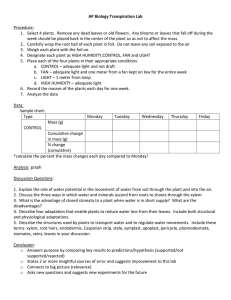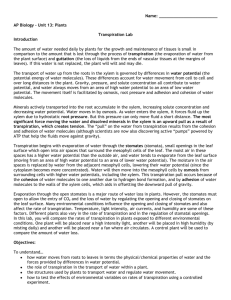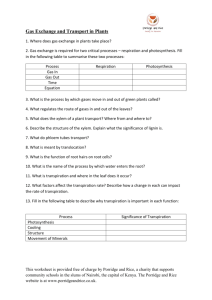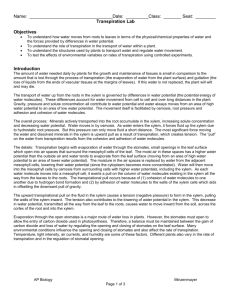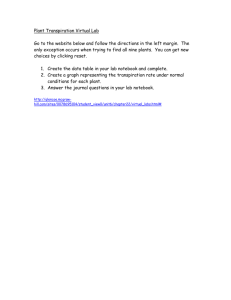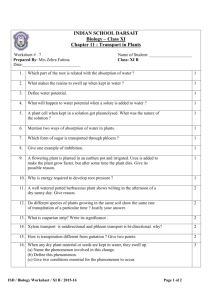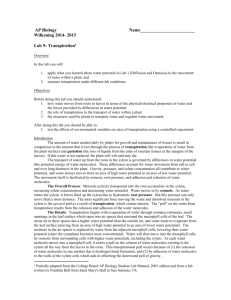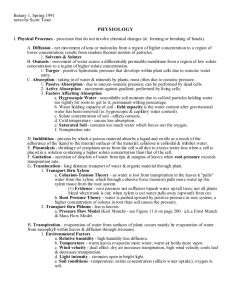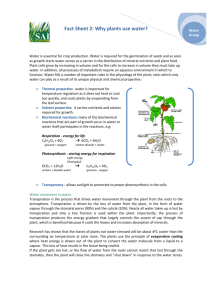AP Biology Transpiration Lab Introduction The amount of water
advertisement
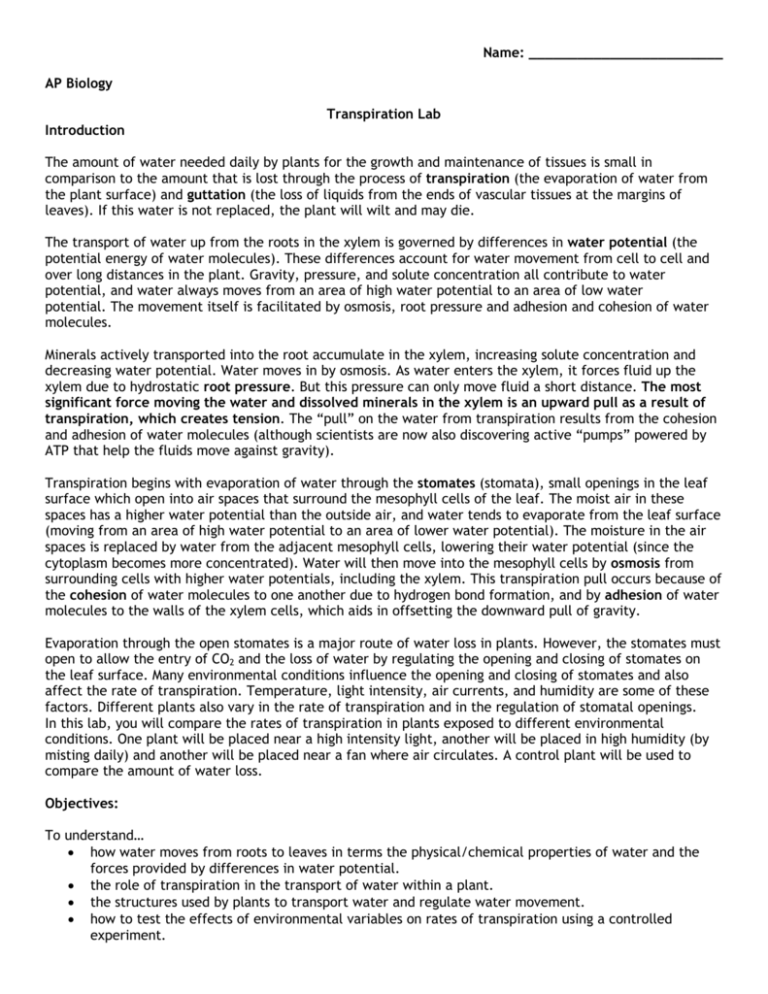
Name: ________________________ AP Biology Introduction Transpiration Lab The amount of water needed daily by plants for the growth and maintenance of tissues is small in comparison to the amount that is lost through the process of transpiration (the evaporation of water from the plant surface) and guttation (the loss of liquids from the ends of vascular tissues at the margins of leaves). If this water is not replaced, the plant will wilt and may die. The transport of water up from the roots in the xylem is governed by differences in water potential (the potential energy of water molecules). These differences account for water movement from cell to cell and over long distances in the plant. Gravity, pressure, and solute concentration all contribute to water potential, and water always moves from an area of high water potential to an area of low water potential. The movement itself is facilitated by osmosis, root pressure and adhesion and cohesion of water molecules. Minerals actively transported into the root accumulate in the xylem, increasing solute concentration and decreasing water potential. Water moves in by osmosis. As water enters the xylem, it forces fluid up the xylem due to hydrostatic root pressure. But this pressure can only move fluid a short distance. The most significant force moving the water and dissolved minerals in the xylem is an upward pull as a result of transpiration, which creates tension. The “pull” on the water from transpiration results from the cohesion and adhesion of water molecules (although scientists are now also discovering active “pumps” powered by ATP that help the fluids move against gravity). Transpiration begins with evaporation of water through the stomates (stomata), small openings in the leaf surface which open into air spaces that surround the mesophyll cells of the leaf. The moist air in these spaces has a higher water potential than the outside air, and water tends to evaporate from the leaf surface (moving from an area of high water potential to an area of lower water potential). The moisture in the air spaces is replaced by water from the adjacent mesophyll cells, lowering their water potential (since the cytoplasm becomes more concentrated). Water will then move into the mesophyll cells by osmosis from surrounding cells with higher water potentials, including the xylem. This transpiration pull occurs because of the cohesion of water molecules to one another due to hydrogen bond formation, and by adhesion of water molecules to the walls of the xylem cells, which aids in offsetting the downward pull of gravity. Evaporation through the open stomates is a major route of water loss in plants. However, the stomates must open to allow the entry of CO2 and the loss of water by regulating the opening and closing of stomates on the leaf surface. Many environmental conditions influence the opening and closing of stomates and also affect the rate of transpiration. Temperature, light intensity, air currents, and humidity are some of these factors. Different plants also vary in the rate of transpiration and in the regulation of stomatal openings. In this lab, you will compare the rates of transpiration in plants exposed to different environmental conditions. One plant will be placed near a high intensity light, another will be placed in high humidity (by misting daily) and another will be placed near a fan where air circulates. A control plant will be used to compare the amount of water loss. Objectives: To understand… • how water moves from roots to leaves in terms the physical/chemical properties of water and the forces provided by differences in water potential. • the role of transpiration in the transport of water within a plant. • the structures used by plants to transport water and regulate water movement. • how to test the effects of environmental variables on rates of transpiration using a controlled experiment. Setting up the Experiment: 1. Select plants that are about the same size. Water and drain them well. 2. Wrap the root ball of each plant with plastic wrap. Use string to tie the plastic wrap so that it is sealed around the stem. Be careful not to damage the stem. 3. Place each plant in a plastic cup to keep them upright throughout the experiment. Label the cup with your group members’ names. 4. Use the digital balance to measure the initial mass of each plant and record it on the plastic cup and in the table below. 5. Place one plant in each of the different environmental conditions in the room. Room Lighting (control) | Humidity | Intense Light | Fan 6. Develop a hypothesis concerning the expected results of the experiment. Write it in the space provided below. 7. Measure the masses of each plant every day for one week and calculate the percent change in mass using the formula below. Hypothesis: Data/Observations: Type Room (Control) Humidity Intense Light Fan Day 1 initial mass mass Day 2 % change mass Day 3 % change mass Day 4 % change Graph: In the space below, graph the percent change in mass over the four days of this experiment. mass Day 5 % change Analysis Questions: 1. For this experiment, what were the independent variable and the dependent variable? 2. From your graph, calculate the average rate of water loss per hour for each of the treatments. Be sure to show your work. a. Room Lighting: b. Humidity: c. Intense Light: d. Fan: 3. Explain why each of the conditions causes an increase or decrease in transpiration compared with the control. a. Room Lighting: b. Humidity: c. Intense Light: d. Fan: 4. How did each condition affect the gradient of water potential from the stem to leaves in the experimental plants? How did this affect the movement of water through the plant? a. Room Lighting: b. Humidity: c. Intense Light: d. Fan: 5. What is the advantage to a plant of closed stomata when water is in short supply? What are the disadvantages? 6. Describe two adaptations that enable plants to reduce water loss from their leaves. Include one structural adaptation and one physiological adaptation. 7. Why did you need to calculate the percent change in mass each day instead of graphing the total amount of water lost each day? Conclusion: In the space below, write a brief conclusion based on your experimental results. Include an analysis of the data with reference to your original hypothesis, as well as a discussion of possible sources of error that may have influenced your results.
